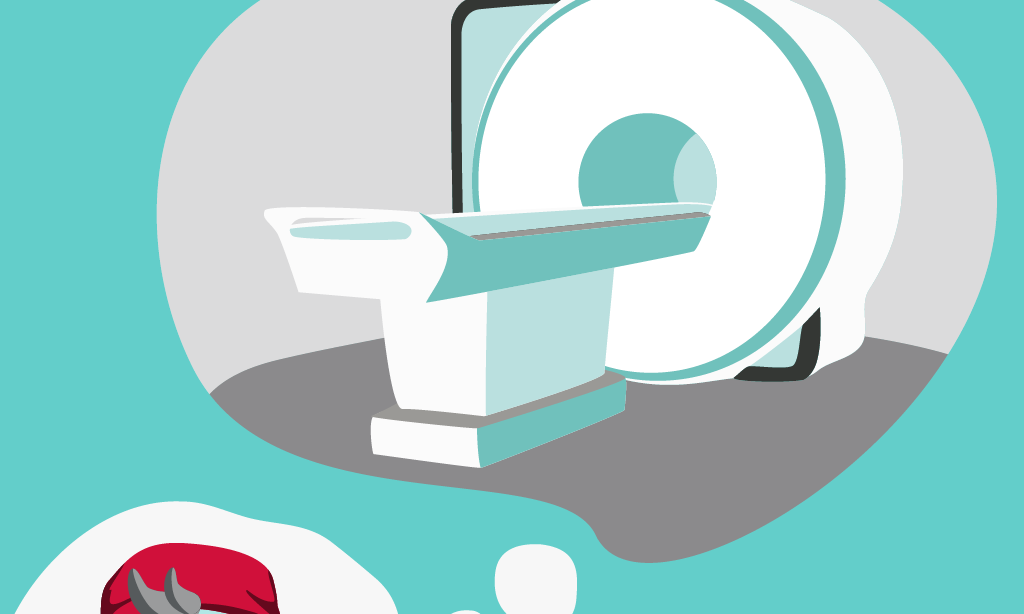Scans for children
Scans are used to give a detailed image of the brain. Your child may have a brain scan so that doctors can see whether a tumour is present and, if it is, its size and position. Scans are used for diagnosis and also for monitoring during and after treatment. The most commonly used scans are CT and MRI scans.
What are the differences between CT and MRI scans?
- MRI scans do not use radiation to produce the images. CT scans use X-rays (radiation), whilst MRI scans use magnetic fields (non-radiation).
- CT scans are quicker and quieter than MRI scans, and children tend to find them less claustrophobic.
- MRI scans usually give more detailed images than CT scans.
- CT scans can be used when there is metal in the body that cannot be removed.
Neither scan is particularly better – it is more a question of which scan is best suited to meet the needs of the patient.

Join our community on Facebook
Our closed Facebook group for parents is a great place to connect with other parents affected by a brain tumour and share your experiences.
CT Scans
CT stands for Computerised Tomography. They are sometimes also called CAT scans.
CT scanners use x-rays to build up a 3D image of the inside of your child’s head. It does this by taking many pictures of 2D ‘slices’ through their head. These slices are then stacked together, using a computer, to make a 3D image.
The CT scanner is shaped like a doughnut with a round hole in the middle – this is where your child’s head will go.
-
The procedure:
- Occasionally your child may be given an injection of a fluid called a ‘contrast medium’ before (or during) the scan, which helps to give a more detailed image of the brain.
- If your child is very young, has claustrophobia or gets anxious, they may be given an oral sedative, or a play therapist will help them prepare for the scan.
- Your child will like on a ‘treatment table’ and medical staff will position them so their head is in the middle of the scanner, it may take some time to get them into the right position.
- Staff will leave the room, but they will be able to see, hear and talk to your child.
- If you are not pregnant, you will be able to stay with your child. You may be given a special apron to wear.
- During the scan, the table will move in and out of the scanner.
- Your child will hear humming sounds form the scanner and louder clicking noises (a little bit like a noisy washing machine on a spin cycle).
- Your child will be able to breathe normally.
- The scan normally takes around 5 – 10 minutes.
- After the scan, your child will usually be allowed to go straight home. If they were given a sedative, the staff will first check that it is safe for them to go home.
MRI Scans
MRI stands for Magnetic Resonance Imaging. This scan uses magnetic fields to build up a 3D image of the brain. It takes ‘pictures’ from several angles around your child’s head to build a detailed picture. It can give many different kinds of information about the tumour and surrounding tissue.
An MRI scanner is an open-ended tunnel. The body part being scanned goes in the middle. For brain tumours, this usually means that your child’s head and shoulders will be in the tunnel. If their spine is also being scanned, then their spine will be in the middle and their head may be near or out of the other (open) end.
-
The procedure:
- Any metal items, such as glasses, hair clips, watches, metal belt buckles and jewellery, will need to be removed, because the MRI machine uses magnets to take images.
- Your child is likely to be given an injection of a fluid called a ‘contrast medium’. This helps to give a more detailed image of the brain.
- If your child is very young, has claustrophobia or gets anxious, they may be given a sedative to make them feel sleepy. Due to the longer length of an MRI, if they are very young, they may need to have a general anesthetic to keep them safely asleep for the whole scan.
- Your child will lie on a motorised bed and a frame placed over their head. This helps to pick up the signals and create a clear image.
- Their head and shoulders will be moved so they are in the right place.
- Staff will leave the room, but they will be able to see, hear and talk to your child.
- You can stay in the room with your child and may wish to place your hand on their leg for reassurance. You will need to remove anything metal, and tell the radiographer if you are in the first three months of pregnancy.
- The scan is very noisy – with loud knocking and clanging noises. Your child will be given headphones or earplugs to wear and you may be able to play music through the headphones. It can be useful to prepare your child before the scan for what they will hear.
- Your child must stay very still during the scan to prevent the pictures of their brain from being blurred.
- The scan usually takes between 30 – 60 minutes.
- After the scan, your child will usually be allowed to go straight home. If they were given a sedative, the staff will first check that it is safe for them to go home.
Before your child’s CT or MRI scan, it is important to let the doctors know if your child gets, or is likely to be very frightened of scans, has any allergies, is on any medications or has had a recent illness.
If your child is frightened of brain scans, check out our hints and tips on how to calm your child before a brain scan
Important information if your child has an adjustable shunt:
If your child has an adjustable shunt, this may need to be reset following an MRI scan, as the magnetic field can change the settings.
Keep a note of the settings of your child’s shunt and check with the medical team that the correct levels have been reset after the scan. It is also good practice to put the settings on a medical alert bracelet, so medics can access them, if they ever need them and you are not there.
Frequently asked questions
-
CT scans – although radiation is used, it is kept at a very low dose. They are used only when they are considered necessary, with the benefits outweighing the risks.
MRI scans – are completely safe. There are no risks associated with them, although they are not suitable for people who have metal in their body (for example, skull plates). Very rarely, the contrast medium can affect the kidneys – tell you child’s medical team if your child has any kidney problems.
-
No, but if your child is given a contrast medium, this may make them feel hot or flushed or feel as if they have urinated (even though they haven’t). These feelings usually last about a minute. Less commonly, some people have reported feeling cold after the contrast medium. Sometimes it can cause a metallic taste in the mouth, so it could be a good idea to bring mints or sweets with you to the appointment.
If your child was given the contrast medium via a ‘cannula’ (tube) in their hand or arm, this area may be a bit sore.
-
If your child feels claustrophobic, it is a good idea to let the hospital know before the day of the scan. They may refer your child to a play therapist, or they can arrange for your child to have a sedative to keep them calm.
With MRI scans, often a mirror can be placed so your child can see out of the scanner, making it feel less enclosed.
-
The radiography team will send a copy of the scan to your child’s medical team in time for your next appointment, when you will be given the results.
How long this takes can vary – it can take some time for the very detailed images to be carefully analysed and discussed by your child’s health team.
You should be given a time frame for your results by your child’s doctor or clinical nurse specialist.
Support and Information Services
Research & Clinical Trials Information
You can also join our active online community.
In this section

Get support
If you need someone to talk to or advice on where to get help, our Support and Information team is available by phone, email or live-chat.
Recommended reading

What happens during a scan?
Our animated video has been designed to help children learn about what happens during a scan.
Get your free Brainy Bag
Our Brainy Bag is a free gift for children and young people who have been diagnosed with a brain tumour, made up of a range of handpicked toys and activities!
Share your experiences and help create change
By taking part in our Improving Brain Tumour Care surveys and sharing your experiences, you can help us improve treatment and care for everyone affected by a brain tumour.